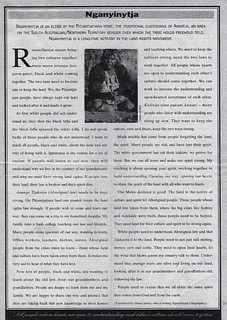At present, the name Pitjantjatjara is used for a language group of original Australian. But before white invasion, the Pitjantjatjara formed a separate tribe on the border of what is now South Australia and Northern Territory. The tribe is split into smaller family groups.
The Pitjantjatjara have a patrilineal kinship. Based on the Tjukurrpa, tribes are split in clans and classes in which everyone has his own place. This is their personal dreaming (also called Totem).
Patrilineal kinships mean that the class and its dreamings are passed on from father to son. The most important aspects of this kinship are the rules regarding family relations, sexual behaviour, and social responsibilities. The tribe is split into family groups. And through the kinship relations all groups have their own place in the tribal structure. Family groups had to look after the land as described before and existed of 25-50 people. They managed and lived on areas of some 2,500 km2.
Men could have more wives, but a wife could only belong to one man. However, during certain ceremonies this structure could alter and could allow a woman to have sexual contact with another man. But the overall rule in such circumstances was always the kinship relations. This prevented unwanted sexual relations within the Pitjantjatjara people.
During our stay with the men in Angatja they informed us (the white men) in great details about the roles of men within these kinship relations which are part of the law elements of the Tjukurrpa. It very much felt as if they were initiating us .

During their nomadic lives, family groups would change. Boys went off during the initiation years, other women would “marry” into the group, etc. At several occasions also groups met at corroborees and other ceremonies. Also, other tribes took part in these events. It was during such events that ties were strengthened, women of marriageable age would be exchanged, disputes such as border crossings discussed, etc. Certain sacred sites were shared by several tribes and rules applied for border crossing, hunting, etc. In severe droughts and or other disasters, tribes would need help of their neighbours, and corroborees were excellent occasions to arrange all these matters. Anangu people travelled up to 500 km to attend such events.
These ceremonies are still playing an important part in the lives of the Anangu and thanks to the modern-day transport facilities they still frequently visit each other.
Most Anangu can easily find their way in areas as large as 50,000 km2 to waterholes, bush food, campsites, firewood, and hunting grounds. Most features in the landscape are in relation to the Tjukurrpa when the All Father (Baiame) shaped the world together with the hero spirits (emu man, goanna man, rainbow serpent). These hero spirits had supernatural power and supernatural sizes, but they also had their nasty habits (lying, adultery, robbery). They formed the land and during their travels on earth, mountains, rivers, waterholes, caves, and rocks were formed.
These features are not just symbolic to the Anangu but are real. The object, say a rock formation, is not only a relic of the creation of such hero spirit, but it can be the spirit itself or a part of it. They very much experience the presence of that spirit at that spot. Some of these sites are sacred, but most are not, depending on the actual value of dreaming. Some are only known to the men, others to the women but even within the sexes there are differences between age groups and clans, each of them have their own (sacred) sites that can be visited, should be visited, can only be visited at certain times or ceremonies or should not be visited at all. And each single situation is linked in the Tjukurrpa.
I discussed with Nganyinta what their Law means for us, white people. What about us visiting sacred sites and perhaps unknowingly trespass their law? She told me that we could not trespass their Law as we are not part of it. So we can safely visit sacred sites as long as we do that respectfully.
Important for the person’s own relation to the Tjukurrpa is also the place where they child is born (where the umbilical cord falls onto the earth). The elder people or the “man with high spirits” (medicine man) could then add, adjust, or change the personal dreaming of that child.
The Pitjantjatjara people believed that very small child spirits would enter the body of the woman through the stomach, the back or under the nail of the thumb. It is unclear but it is now thought that this had more to do with the spirit of the child than the actually biological process.
Within a certain kinship relation all “marriageable” women of an initiated man were called wives. A child born within such a group was called a son by all the aunts of the family. There are no different names for the different relations within their language as we know them. This did not matter at all because their family rights and plights were not based on sexual relations and marriage as we know it but on the kinship relation.

